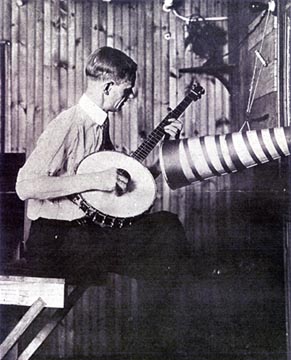Van Eps was born in Somerville in New Jersey. He moved to Plainfield with his family in 1892. He studied Vess Ossman’s phonograph recordings and learned how to play the banjo. Van Eps was hired in 1897 by Thomas Edison’s National Phonograph Company, West Orange, New Jersey. He worked as a studio technician. Edison was pleased with the sales of Van Eps’ cylinder recordings. Many were remakes Ossman tunes. Van Eps’ early ragtime banjo recordings included “A Bunch of Rags”, (1900), and “A Ragtime Episode,” (1902). He recorded for several other companies, including Victor (from 1910) and Columbia (from 1904). The Van Eps Trio, his group, recorded continuously from 1912 to 19.22. Other groups he led included the Van Eps Quartet and Van Eps Specialty Four. He was also the Van Eps Banjo Orchestra. The American branch of French Pathe Freres Company recorded the group in 1914. Orlando Kellum, the inventor of the Photokinema sound on-disc sound film system, shot the Van Eps Trio’s performance in The Famous Van Eps Trio with a Bit of Jazz in 1921. He formed a company with Henry Burr that manufactured and sold Van Eps Recording Banjos, which were modeled after the one he used for recordings and concerts. The banjo was still in use until 1930 when electric recording made it unnecessary to produce the volume required by the Van Eps model. The banjo was no longer in fashion and Van Eps began to play guitar as a studio musician alongside Ray Noble, Benny Goodman and Red Norvo. He recorded some pieces with Frank Lawes (British banjo composer). He attempted to make a comeback in the 1950s with several banjo recordings before he died in Burbank, California, at the age of 81. Van Eps was also a vaudeville performer and had an influence on pre-bluegrass musicians such as Charlie Poole, the North Carolina Ramblers, and others. He was the father to jazz guitarist George Van Eps. Wikipedia
